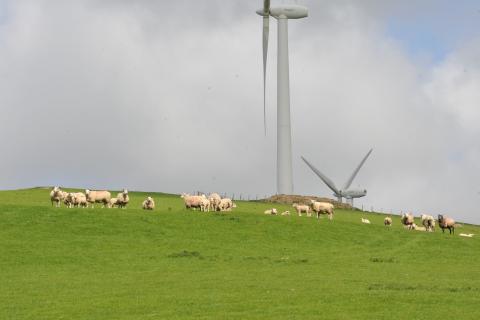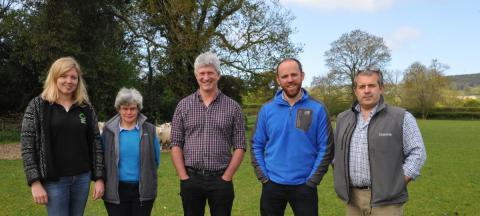17 May 2018
Lamb producers in the Welsh uplands are being urged to consider planting new hedges and trees and
restore neglected woodland and hedges to increase shelter after one of the harshest springs on record has taken its toll on flock productivity.
Although shelter belts have been in existence for decades, the frequency of severe weather events and a move towards outdoor lambing systems has renewed interest in their role in young lamb survival.
Some systems, such as rotational grazing, can influence accessibility to shelter, as farmers heard during a Farming Connect open day at Peithyll, Innovis’s upland farm at Capel Dewi, Ceredigion.
Peithyll, a Farming Connect Innovation Site, aims to maximise productivity from grazed grass, managing covers through grass measuring and electric fencing. Dewi Jones, managing director of Innovis, says this creates a different environment for sheep within that field.
“By putting in electric fencing, especially in an upland situation, you are changing the dynamic of that field,’’ he explained.
“We are working with Bangor University to establish how windflow and exposure on our farm operates and how we are affecting that by having rotational grazing and other systems in place here.’’
Some of that research has been used by the university to develop a new web-based app that allows farmers to work out where best to locate tree or hedgerow-shelter in fields prone to exposure.
The ‘Cysgod y Gwynt’ app was developed as part of Multi-Land, a research partnership that looks at ways to increase farm profitability and efficiency through sustainable agriculture, whilst improving resilience of the farmland landscape.
Andy Smith, a senior lecturer in forestry at Bangor University, a speaker at the Farming Connect open day, said by inputting farm specific data into the app it can work out the optimal configuration of tree shelter in the landscape for livestock.
Exposure to cold is one of the biggest reasons for neonatal loss of lambs but sheltered fields provide good conditions for lambing and mothering.
Prysor Williams, who also lectures at Bangor University, said farmers recognised the value of shelter during the recent harsh weather conditions.
“Shelter belts can provide benefits during lambing but also in the summer, they really are invaluable,’’ he told farmers at the open day.
“They are not new, we have had shelter belts for decades, but I think we are going full circle as there is a renewed interest in them because we seem to be getting harsher winters and more extreme weather events.’’
The growing popularity of outdoor lambing together with labour availability changes to reduce the cost of production have been influential in that.
Not only is shelter important to livestock productivity in an upland situation but so too is measuring and monitoring.
Innovis has been using data gathered during a Farming Connect high frequency weighing project to support its rotational grazing policies.
This project is co-ordinated by Farming Connect which is funded by the European Agricultural Fund for Rural Development and the Welsh Government.
Dr Janet Roden, of Innovis, said frequent weighing used in conjunction with EID allows the farm to monitor lamb growth and alter flock management as needed.
“An example of this is when we were weighing last summer. We noticed that some of the lambs were falling behind target weight gain so they went forward into the next covers at a lower stocking density and picked up weight gain before joining the main mob again,’’ she said.
“By keeping an eye on weight gains over the season and measuring these against target weight gains and other information, we brought a pasteurella booster forward because we felt it was necessary. The weights added a bit of evidence to that decision.
“Also, with mob faecal egg counts, the weighing helps us to make a decision as to the best time to worm or maybe not worm.’’
Although Innovis has the infrastructure to weigh lambs frequently, weighing a sample group of lambs with basic equipment will give a good indication of performance, especially at around eight weeks, weaning and through to finishing.
“Knowing the daily liveweight gain will highlight any issues such as parasite burden before they have a significant effect on the lambs,’’ said Lisa Roberts, Red Meat Technical Officer at Farming Connect, who facilitated the open day.
Upland hill farming at high altitudes can bring its own set of challenges but strategically planting trees and hedgerows can improve animal welfare and increase productivity.
To aid this, the Sustainable Management Scheme (SMS) offers grants for a range of activities that improve the management of Wales’s natural resources, said Geraint Jones, Forestry Technical Officer at Farming Connect.
“There are opportunities to implement capital works and improve the environmental performance of the farm, such as siting trees to aid livestock handling and collection, fencing out steep dingles and slopes to benefit livestock. The Cysgod y Gwynt app can aid the design and location for these,’’ said Mr Jones.
The support service that helps groups apply for the funding is being delivered by Menter a Busnes under the Farming Connect Programme on behalf of the Welsh Government Rural Communities – Rural Development Programme 2014 – 2020, which is funded by the European Agriculture Fund for Rural Development and the Welsh Government.


